The Complete Book of 2000s Broadway Musicals
The Complete Book of 2000s Broadway Musicals
Dan Dietz
ROWMAN & LITTLEFIELD
Lanham Boulder New York London
Published by Rowman & Littlefield
A wholly owned subsidiary of The Rowman & Littlefield Publishing Group, Inc.
4501 Forbes Boulevard, Suite 200, Lanham, Maryland 20706
www.rowman.com
Unit A, Whitacre Mews, 26-34 Stannary Street, London SE11 4AB
Copyright 2017 by Rowman & Littlefield
All rights reserved . No part of this book may be reproduced in any form or by any electronic or mechanical means, including information storage and retrieval systems, without written permission from the publisher, except by a reviewer who may quote passages in a review.
British Library Cataloguing in Publication Information Available
Library of Congress Cataloging-in-Publication Data
Names: Dietz, Dan, 1945
Title: The complete book of 2000s Broadway musicals / Dan Dietz.
Description: Lanham : Rowman & Littlefield, [2017] | Includes bibliographical references and index.
Identifiers: LCCN 2016049522 (print) | LCCN 2016049689 (ebook) | ISBN 9781442278004 (hardback : alk. paper) | ISBN 9781442278011 (electronic)
Subjects: LCSH: MusicalsNew York (State)New York21st centuryHistory and criticism.
Classification: LCC ML1711.8.N3 D535 2017 (print) | LCC ML1711.8.N3 (ebook) DDC 792.6/45097471dc23
LC record available at https://lccn.loc.gov/2016049522
 The paper used in this publication meets the minimum requirements of American National Standard for Information SciencesPermanence of Paper for Printed Library Materials, ANSI/NISO Z39.48-1992.
The paper used in this publication meets the minimum requirements of American National Standard for Information SciencesPermanence of Paper for Printed Library Materials, ANSI/NISO Z39.48-1992.
Printed in the United States of America
To the memory of my beloved maternal grandparents,
Olympia DeMarinis Cioffi and James Cioffi
Acknowledgment
I want to thank Mike Baskin for his invaluable help and support in the writing of this book.
Introduction
The Complete Book of 2000s Broadway Musicals examines in detail all 213 revues and musicals that opened in New York between January 1, 2000, and December 31, 2009. It includes comedy and magic revues (some of which contained music) and shows that closed prior to New York (some of the latter had not booked a Broadway theatre or set an opening date, but it seems likely they would have opened in New York had their reviews been favorable).
The productions discussed in this book are: thirty-seven book musicals with new music; fifteen book musicals that include preexisting music; two plays with incidental songs; five traditional revues; twenty-one personality revues and concerts; two magic revues; eighteen musicals and revues that originated Off Broadway or Off Off Broadway; twenty-five imports; thirty-one commercial revivals; twenty-one noncommercial revivals; six return engagements; and thirty pre-Broadway closings. For a quick rundown of these productions, see Alphabetical List of Shows; Chronology (by Season) (Appendix A); and Chronology (by Classification) (Appendix B).
Like the other books in this series, my goal is to provide a convenient reference source that gives both technical information (such as cast and song lists) and commentary (including obscure details that personalize both familiar and forgotten musicals).
The decade was notable for old-fashioned, feel-good shows ( The Full Monty , The Producers , Mamma Mia! , Hairspray , Spamalot , Jersey Boys ); a number of family-friendly musicals, many of them aimed at the little-girl and teenage-girl market ( Wicked , Little Women , Chitty Chitty Bang Bang , Tarzan , Mary Poppins , and The Little Mermaid ); numerous revivals ( Follies , Bells Are Ringing , 42nd Street , Oklahoma! , Wonderful Town ); a stunning dance musical ( Contact ); a handful of serious musicals that enjoyed reasonably long runs and various awards ( The Light in the Piazza , Grey Gardens , and the Pulitzer Prizewinning Next to Normal ); and a number of gargantuan flops (including a trio of anemic vampire musicals, Dance of the Vampires , Dracula , and Lestat ).
Unlike earlier decades that were dominated by specific composers (such as Stephen Sondheim and Andrew Lloyd Webber), by numerous British imports, or by a new form of musical-theatre storytelling (the concept musical), the decade is perhaps most notable for the rise of shows that kidded musical-comedy conventions and wore irony on their sleeves. These included The Producers , Urinetown , Dirty Rotten Scoundrels , Spamalot , The Drowsy Chaperone , Kiki & Herb: Alive on Broadway , Martin Short: Fame Becomes Me , Curtains , Xanadu , Young Frankenstein , and, yes, even one titled [title of show] .
On an ominous note, there were an inordinate number of revivals (both commercial and institutional). Just thirty-seven new book musicals with new music opened, but fifty-eight revivals and return engagements were presented (thirty-one commercial revivals, twenty-one institutional revivals, and six return engagements). Compare these numbers with earlier decades: The 1940s offered eighty new book musicals with new music and forty-one commercial revivals, institutional revivals, and return engagements; the 1950s, seventy-one new book musicals with new music and fifty-four revivals and return engagements (of which ten were commercial revivals); the 1960s with no less than ninety-eight book musicals with new music, and just one commercial revival (and sixty-four institutional revivals and return engagements); the 1970s with eighty-four book musicals with new music and a combination of fifty-seven commercial revivals, institutional revivals, and return engagements; the 1980s with fifty book musicals with new music and eighty revivals evenly split between commercial and institutional productions; and the 1990s with thirty-two book musicals with new music and fifty-seven revivals, forty-two of which were commercial presentations.
The decade also saw a precipitous decline in the number of Gilbert and Sullivan revivals, and virtually the only G & S presentations of note were those produced by the stalwart New York Gilbert & Sullivan Players. And while Radio City Music Hall remained active with its seasonal holiday shows and various concerts, only one of its productions (the import Dancing on Dangerous Ground ) could be classified as a Broadway-styled show.
In another sign of the passing of eras, the decade was the first since the 1940s which didnt see the Broadway premiere of a new Sondheim musical. However, in 2000 Off Broadway saw the New York premiere of his musical Saturday Night (which had originally been scheduled to open on Broadway during the 19541955 season). In addition, Chicago and Washington, D.C., saw his musical Bounce (aka Wise Guys and Gold! ), but the show didnt transfer to Broadway (however, as Road Show , a revised version was produced Off Broadway in 2008).
In regard to the technical information in this book, each entry includes: name of theatre; opening and closing dates; number of performances (taken from Best Plays or Theatre World ); the shows advertising tag (including variations used in advertisements); and names of book writers, lyricists, composers, directors, choreographers (some of whom were credited for musical staging as opposed to traditional choreography), musical directors (conductors), producers, scenic designers, costume designers, and lighting designers. The names of the cast members are included, and each performers name is followed by the name of the character portrayed (names in italics reflect those performers who were billed above the title). This book doesnt include the names of all the individuals associated with a particular production; accordingly, swings, understudies, and technical personnel are generally not referenced.
Technical information also includes the number of acts for each show, the time and locale of the action, and the titles of musical numbers by act (each song title is followed by the name of the performer, not the name of the character, who introduced the song). If a song is known by a variant title, the alternate one is also given. If a musical is based on source material, such information is cited.
Next page
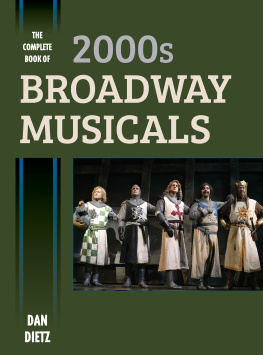
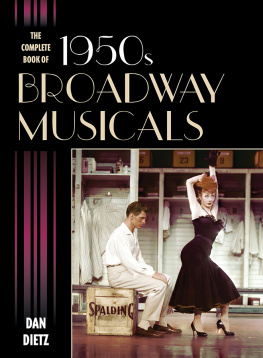


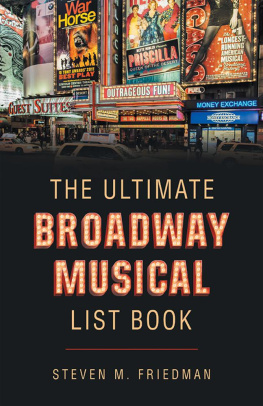
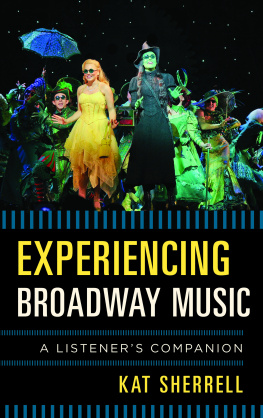



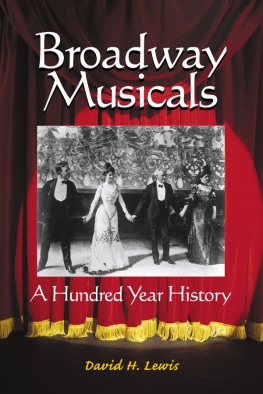
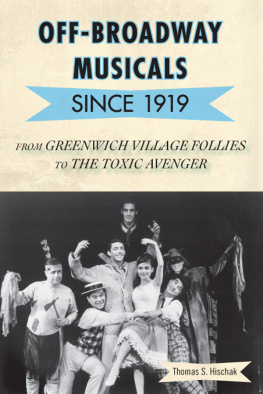
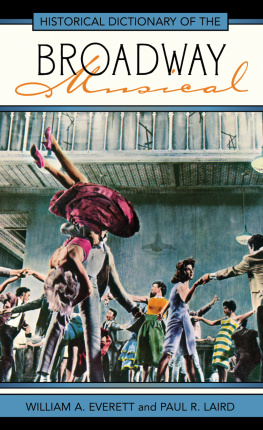

 The paper used in this publication meets the minimum requirements of American National Standard for Information SciencesPermanence of Paper for Printed Library Materials, ANSI/NISO Z39.48-1992.
The paper used in this publication meets the minimum requirements of American National Standard for Information SciencesPermanence of Paper for Printed Library Materials, ANSI/NISO Z39.48-1992.